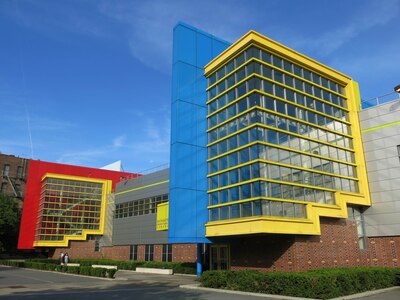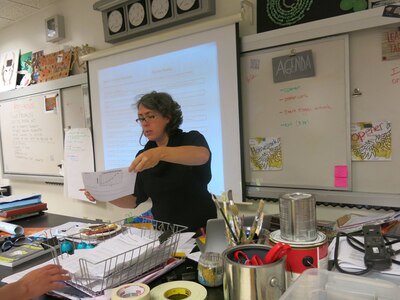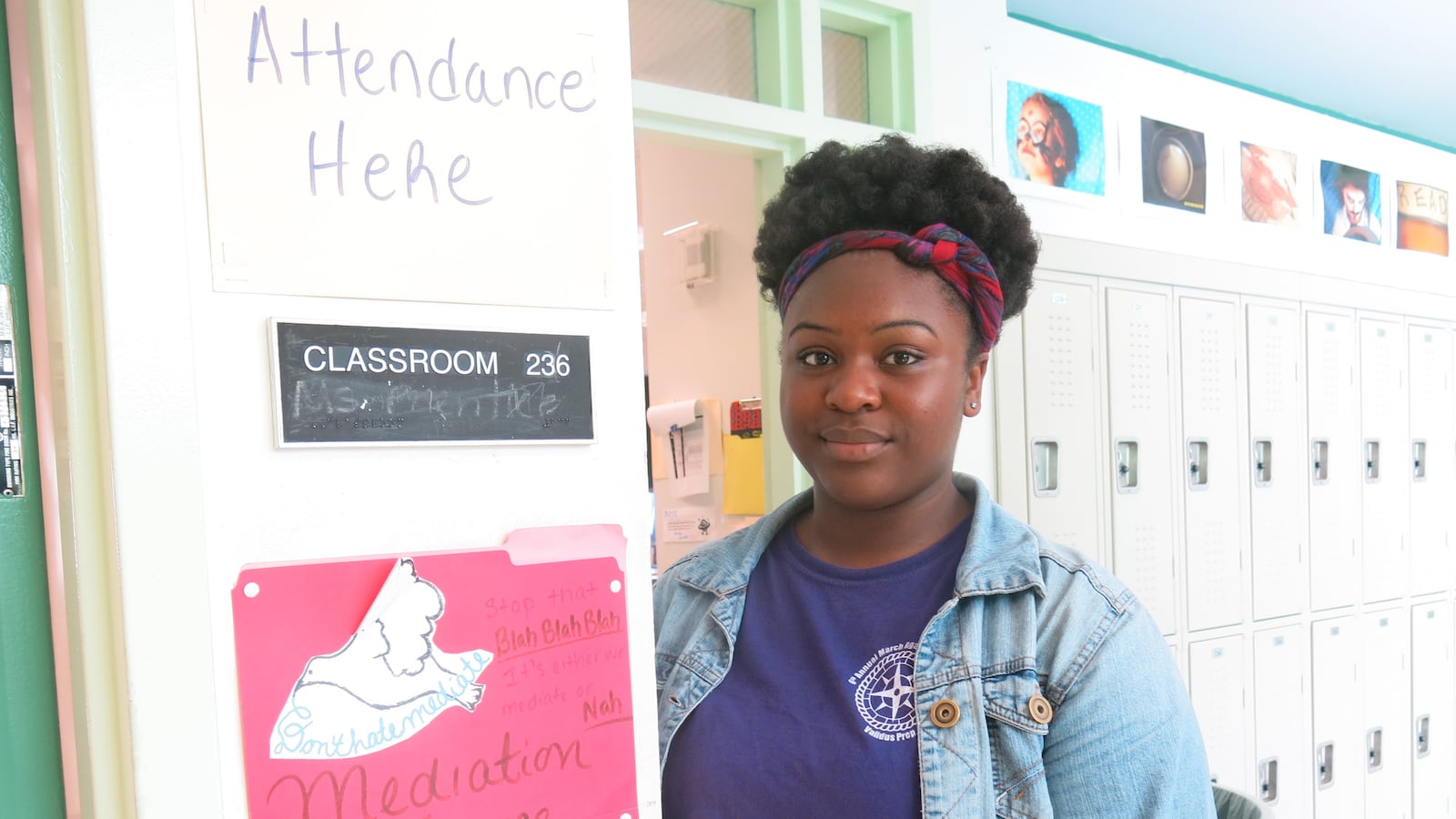It’s a clear morning in mid-June, and Validus Preparatory Academy in the Bronx has that end-of-the-school-year feel. Students bid farewell to teachers, seniors tote freshly printed yearbooks, and most noticeably, students are allowed to disregard the school uniform without a call home or a trip to the principal’s office.
Yet even on a regular day, breaking the dress code would not lead to these consequences. In Validus terms, offenders would be “brought to Fairness” instead.
Validus, a small high school opened during the Bloomberg administration, is one of a number of city schools using restorative justice practices like student justice panels that are meant to provide useful alternatives to punitive discipline.
For the past few years, the Department of Education has been quietly building its capacity to implement restorative justice programs. Most recently, the department’s Office of Safety and Youth Development verbally committed to expanding the programs next year by providing funding that would allow schools to hire restorative justice coordinators and train staff members.
Though the number of schools involved and the dollar amount each would receive have yet to be determined, a proposal presented by the New York chapter of the Dignity in Schools Campaign last December outlines an $8.75 million investment: a pilot cohort of 10 schools, each receiving $175,000 annually for five years.
That would be a significant step in a citywide shift toward restorative justice that Chancellor Carmen Fariña promoted in May, and Mayor Bill de Blasio called for as public advocate.
A closer look at restorative justice in action reveals the challenges the city is likely to face in spreading these programs. The schools currently using restorative approaches tend to be small, young, and emphasize social-emotional learning. Educators at these schools say the programs are essential to creating a safer, more respectful environment. But for an expansion to work, other schools must commit to rethinking the “why” and “how” of school discipline.
Analyzing the programs in practice
“Restorative justice is about creating new systems where we’re building relationships,” said Anne Looser, a special education teacher at the Urban Assembly Bronx Academy of Letters, which has a restorative justice program. “We’re putting supports into place so young people don’t get lost.”
These supports can take the form of student justice panels, peer mediation programs, “restorative circles,” and other methods. They all aim to change students’ offending behaviors and repair damaged relationships through resolutions like writing an apology note or helping out a teacher.

In contrast, restorative justice supporters argue, using suspensions as the universal consequence for behavior incidents further alienates at-risk students and often fails to address the root of their behavioral problems.
Suspensions from city schools decreased 27 percent between 2010 and 2013, though there were still 53,465 suspensions last year. For schools looking to reduce their reliance on punitive discipline, restorative justice programs are meant to provide teachers and students with multiple options for dealing with conflict.
At Validus, the Fairness Committee independently handles a wide range of offenses, from incidents of bullying to small disruptions like violating the cell phone policy. The most severe infractions, such as those involving drugs or weapons, are sent directly to the administration.
Fairness Committee meets once or twice a week, and all students rotate serving as panelists. A teacher facilitator leads the group in discussing the student’s actions and creating resolutions to right the wrong.
Validus also runs a peer mediation program, which art and chemistry teacher Jamie Munkatchy believes has led to changes in the school culture. “There seems to be this sort of tangential effect,” she said. “Because students know there’s a peer mediation program, they seem to just be aware of conflict resolution. They don’t glorify fighting.”
“I think it’s good for teachers too,” said senior Judith Nkwor, who is a peer mediator. “They don’t feel hopeless when they’re dealing with students; they have an option to help them stay focused and make them accountable for their actions.”
At Flushing International High School, the Lyons Community School, and the Bronx Academy of Letters, restorative justice often occurs in “restorative circles”—gatherings where participants sit in a circle to build community through conversation. The schools use circles in classroom discussions, to address discipline issues, to comfort students dealing with trauma, or to reintegrate students into the school after a suspension.
According to Flushing International social worker Tania Romero, the environment at her school “has become much more peaceful.”
This year, Romero added, circles have helped “open up conversations in more meaningful and deeper ways,” allowing students to discuss issues like racism.
At the moment, it’s difficult to judge whether these programs have reduced suspensions. Some schools, such as Lyons, said they do not keep such records, and others, including Validus, Bronx Letters, and Flushing International, would not share these numbers with Chalkbeat. But educators at these schools say that punitive measures have decreased as a result of restorative programs.
They also stress, however, that restorative justice is not intended to replace suspensions entirely.
“Do we use suspensions all the time? Yes. But we have a larger bank of tools,” explained Lyons Principal Taeko Onishi. “Our goal is to make sure in each case that we consider the restorative options before we go another route, or we use them in tandem.”
Taking restorative justice to the next level
Interestingly, many of the schools using restorative justice share certain qualities. Validus, Lyons, Letters, and Flushing International were all founded in the 2000s, maintain a student body under 600, and started restorative justice programs within the past five or so years.
Each school also has a specific focus. The Bronx Academy of Letters emphasizes writing skills, Flushing International works with students who have recently immigrated, and Validus is an Outward Bound expeditionary learning school, for example. In recent years, all have dedicated time and resources to establishing a school climate where communication and support are highly prized to accommodate restorative justice.
To some, scaling up restorative justice programs to very different schools could present challenges.
Creating a culture where educators default to restorative practices instead of suspensions takes time, Munkatchy explained. In fact, it’s still an adjustment at her own school.
“Is insubordination a suspendable offense?” she asked. “If a kid says ‘f— you,’ at the moment, seven or eight of our faculty will say it’s a suspendable offense. I feel like that is a really poor relationship between a kid and an adult.”

Getting students to buy in to the programs is another hurdle, one that Onishi said took years to overcome at Lyons. But now, if a new student doesn’t take restorative justice seriously, “I’ll get the coolest 11th grader to come tell them to buy in,” she said.
Looser, the special education teacher at Letters, formerly taught at Lehman High in the Bronx, a school of about 2,000 students that was nearly shut down by the city in 2012 and again in 2013.
Lehman ran a mentoring program that paired seniors with freshmen, and a number of teachers were trained in restorative justice practices. But “because the school was going through so much turmoil, there was constant interruption of consistency of service,” Looser said.
Yet the size of the school itself was not an issue, she said. If anything, it was easier to gather a pool of teachers for training since the staff was so large. A larger faculty would also mean less time and effort required from individual teachers to support restorative justice.
For now, the scope of the department’s commitment to expanding restorative justice to additional schools is uncertain. But the Dignity in Schools Campaign, a nonprofit focused on discipline reform, has a clear a long-term vision: a restorative justice coordinator at every school in the city.
Instead of teachers volunteering to organize different aspects of a restorative justice program, as is the case at Validus, a single staff member would organize the program holistically. This coordinator would also be responsible for tracking and analyzing statistics that could show the programs’ effectiveness.
“It is not an impossible task,” said Shoshi Chowdhury, a campaign coordinator for Dignity in Schools. “But the administration has to be on board.”
The city would not comment directly on its plans to expand restorative justice programs or provide the number of existing programs across the city. A spokeswoman said the department has been meeting with community groups and principals to discuss alternative forms of discipline. Reducing reliance on suspensions is “a top priority for Chancellor Fariña,” the spokeswoman said in a statement.
Looking at the big picture
School discipline reform is gaining momentum nationwide, with restorative justice practices taking hold in Oakland, Calif. and other school districts. In January, Secretary of Education Arne Duncan and Attorney General Eric Holder announced a set of guidelines meant for “improving school climate and discipline,” the first such guidelines released on a federal level.
Back in New York, the department is poised to significantly change the way it disciplines its students. “Under the Bloomberg administration, with the very, sort of, heavy emphasis on accountability, there was a lot of breakdown of trust necessary to make the school system function in the best way it can function,” Morningside Center Deputy Executive Director Tala Manassah said, though she noted that some Bloomberg-era officials were supportive of restorative justice.
Over the past few years, the Department of Education has sent teachers from 55 middle and high schools to receive training in restorative approaches from the Morningside Center, which will be training 45 more schools this July and plans to add another 45 in the fall.
Fariña’s administration, she believes, “has already shown itself to be extremely aligned with this kind of work.”
Still, Onishi cautioned that restorative justice is not an immediate fix-all.
“Saying, ‘The kid cursed at me yesterday, did restorative justice, and cursed at me tomorrow’ is not a fair way to measure its success,” she explained. “Our goal is not for you to suddenly be good. Our hope is that the behavior is less severe and it happens less frequently. It’s a progression.”
Later this week, Chalkbeat will publish an in-depth look at suspension policies in New York City schools. Sign up for our morning newsletter to stay in the loop.

